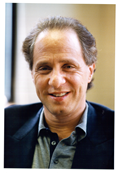 Ray
Kurzweil: a Brief Career Summary (Autumn 2002)
Ray
Kurzweil: a Brief Career Summary (Autumn 2002) Ray
Kurzweil: a Brief Career Summary (Autumn 2002)
Ray
Kurzweil: a Brief Career Summary (Autumn 2002)
Ray Kurzweil was the principal developer of the first omni-font optical character recognition, the first print-to-speech reading machine for the blind, the first CCD flat-bed scanner, the first text-to-speech synthesizer, the first music synthesizer capable of recreating the grand piano and other orchestral instruments, and the first commercially marketed large-vocabulary speech recognition. Ray has successfully founded and developed nine businesses in OCR, music synthesis, speech recognition, reading technology, virtual reality, financial investment, medical simulation, and cybernetic art. All of these technologies continue today as market leaders. Ray's Web site, KurzweilAI.net, is a leading resource on artificial intelligence.
Ray Kurzweil was inducted into the National Inventors Hall of Fame, established by the U.S. Patent Office, in 2002, and received the $500,000 Lemelson-MIT Prize, the nation's largest award in invention and innovation. He also received the 1999 National Medal of Technology, the nation's highest honor in technology, from President Clinton in a White House ceremony. He has also received scores of other national and international awards, including the 1994 Dickson Prize (Carnegie Mellon University's top science prize), Engineer of the Year from Design News, Inventor of the Year from MIT, and the Grace Murray Hopper Award from the Association for Computing Machinery. He has received eleven honorary Doctorates and honors from three U.S. presidents. He has received seven national and international film awards. His book, The Age of Intelligent Machines, was named Best Computer Science Book of 1990. His current best-selling book, The Age of Spiritual Machines, When Computers Exceed Human Intelligence has been published in nine languages and achieved the #1 best selling book on Amazon in the categories of "Science" and "Artificial Intelligence."